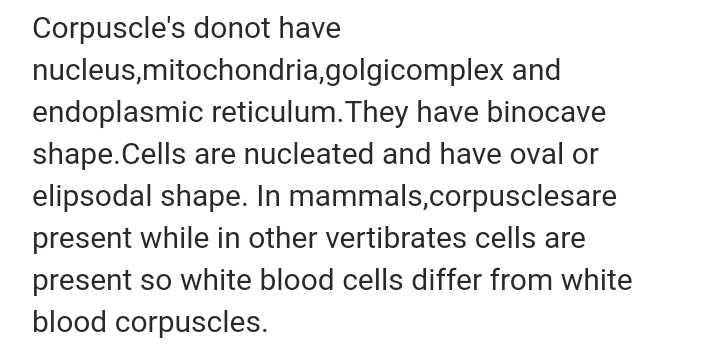NEET Exam > NEET Questions > Difference between red blood cell and corpusc...
Start Learning for Free
Difference between red blood cell and corpuscle?
Most Upvoted Answer
Difference between red blood cell and corpuscle?
Red Blood Cell vs Corpuscle
Red blood cells and corpuscles are terms that are often used interchangeably to refer to the same thing. However, there are some differences between the two.
Definition
- Red blood cells are the most common type of blood cell and are responsible for carrying oxygen from the lungs to the rest of the body. They are also known as erythrocytes.
- Corpuscles, on the other hand, are a term used to refer to blood cells in general, including red blood cells, white blood cells, and platelets.
Structure
- Red blood cells are biconcave in shape, which gives them a larger surface area to volume ratio, allowing for more efficient oxygen transport. They do not have a nucleus or any other organelles, as they are essentially just sacs filled with hemoglobin.
- Corpuscles, in general, have a more complex structure. White blood cells have a nucleus and various organelles, while platelets are much smaller and have no nucleus at all.
Function
- The main function of red blood cells is to transport oxygen from the lungs to the rest of the body. They do this by binding to oxygen molecules in the lungs and then releasing them when they reach tissues that need oxygen.
- The functions of other types of corpuscles vary. White blood cells are part of the immune system and help to fight off infections and diseases. Platelets are responsible for blood clotting, which helps to prevent excessive bleeding.
Conclusion
In summary, while red blood cells are a type of corpuscle, the term corpuscle is more general and can refer to any type of blood cell. Red blood cells are specialized for oxygen transport and have a unique biconcave shape, while other types of corpuscles have different functions and structures.
Red blood cells and corpuscles are terms that are often used interchangeably to refer to the same thing. However, there are some differences between the two.
Definition
- Red blood cells are the most common type of blood cell and are responsible for carrying oxygen from the lungs to the rest of the body. They are also known as erythrocytes.
- Corpuscles, on the other hand, are a term used to refer to blood cells in general, including red blood cells, white blood cells, and platelets.
Structure
- Red blood cells are biconcave in shape, which gives them a larger surface area to volume ratio, allowing for more efficient oxygen transport. They do not have a nucleus or any other organelles, as they are essentially just sacs filled with hemoglobin.
- Corpuscles, in general, have a more complex structure. White blood cells have a nucleus and various organelles, while platelets are much smaller and have no nucleus at all.
Function
- The main function of red blood cells is to transport oxygen from the lungs to the rest of the body. They do this by binding to oxygen molecules in the lungs and then releasing them when they reach tissues that need oxygen.
- The functions of other types of corpuscles vary. White blood cells are part of the immune system and help to fight off infections and diseases. Platelets are responsible for blood clotting, which helps to prevent excessive bleeding.
Conclusion
In summary, while red blood cells are a type of corpuscle, the term corpuscle is more general and can refer to any type of blood cell. Red blood cells are specialized for oxygen transport and have a unique biconcave shape, while other types of corpuscles have different functions and structures.
Community Answer
Difference between red blood cell and corpuscle?


|
Explore Courses for NEET exam
|

|
Similar NEET Doubts
Difference between red blood cell and corpuscle?
Question Description
Difference between red blood cell and corpuscle? for NEET 2025 is part of NEET preparation. The Question and answers have been prepared according to the NEET exam syllabus. Information about Difference between red blood cell and corpuscle? covers all topics & solutions for NEET 2025 Exam. Find important definitions, questions, meanings, examples, exercises and tests below for Difference between red blood cell and corpuscle?.
Difference between red blood cell and corpuscle? for NEET 2025 is part of NEET preparation. The Question and answers have been prepared according to the NEET exam syllabus. Information about Difference between red blood cell and corpuscle? covers all topics & solutions for NEET 2025 Exam. Find important definitions, questions, meanings, examples, exercises and tests below for Difference between red blood cell and corpuscle?.
Solutions for Difference between red blood cell and corpuscle? in English & in Hindi are available as part of our courses for NEET.
Download more important topics, notes, lectures and mock test series for NEET Exam by signing up for free.
Here you can find the meaning of Difference between red blood cell and corpuscle? defined & explained in the simplest way possible. Besides giving the explanation of
Difference between red blood cell and corpuscle?, a detailed solution for Difference between red blood cell and corpuscle? has been provided alongside types of Difference between red blood cell and corpuscle? theory, EduRev gives you an
ample number of questions to practice Difference between red blood cell and corpuscle? tests, examples and also practice NEET tests.

|
Explore Courses for NEET exam
|

|
Signup for Free!
Signup to see your scores go up within 7 days! Learn & Practice with 1000+ FREE Notes, Videos & Tests.


























